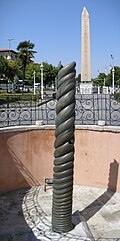ستون مار


ستون مار (یونانی باستان: Τρικάρηνος Ὄφις Τrikarenos Οphis "مار سه سر";[۱] ترکی استانبولی: Yılanlı Sütun "ستون مارپیچ") همچنین به عنوان ستون ماری، سهپایه پلاتین یا سهپایه دلفی شناخته میشود، یک ستون برنزی باستانی در هیپودروم قسطنطنیه (معروف به میدان اسب (به ترکی استانبولی: Atmeydanı) در دوره عثمانی) در استانبول فعلی ترکیه است. این بخشی از یک سهپایه ایثارگری در یونان باستان است که در ابتدا در دلفی یونان بود و توسط کنستانتین یکم در سال ۳۲۴ به قسطنطنیه انتقال داده شد. این ستون برای بزرگداشت یونانیانی که در نبرد پلاته (۴۷۹ قبل از میلاد) با امپراتوری هخامنشی جنگیدند و آن را شکست دادند، ساخته شد. سرهای مار ستون ۸ متری تا پایان قرن هفدهم دست نخورده باقی مانده بودند (یکی از سرها در موزه باستانشناسی استانبول به نمایش گذاشته شده است). [۲]
پانویس
[ویرایش]- ↑ Τρικάρηνος ὄφις ὁ χάλκεος, i.e. "the bronze three-headed serpent"; see Herodotus (1920). "9.81.1". Histories. with an English translation by A. D. Godley. Cambridge: Harvard University Press.
See also τρικάρηνος, ὄφις. Liddell, Henry George; Scott, Robert; A Greek–English Lexicon at Perseus Project.συμφορήσαντες δὲ τὰ χρήματα καὶ δεκάτην ἐξελόντες τῷ ἐν Δελφοῖσι θεῷ, ἀπ᾽ ἧς ὁ τρίπους ὁ χρύσεος ἀνετέθη ὁ ἐπὶ τοῦ τρικαρήνου ὄφιος τοῦ χαλκέου ἐπεστεὼς ἄγχιστα τοῦ βωμοῦ, καὶ τῷ ἐν Ὀλυμπίῃ θεῷ ἐξελόντες, ἀπ᾽ ἧς δεκάπηχυν χάλκεον Δία ἀνέθηκαν, καὶ τῷ ἐν Ἰσθμῷ θεῷ, ἀπ᾽ ἧς ἑπτάπηχυς χάλκεος Ποσειδέων ἐξεγένετο, ταῦτα ἐξελόντες τὰ λοιπὰ διαιρέοντο, καὶ ἔλαβον ἕκαστοι τῶν ἄξιοι ἦσαν, καὶ τὰς παλλακὰς τῶν Περσέων καὶ τὸν χρυσὸν καὶ ἄργυρον καὶ ἄλλα χρήματα τε καὶ ὑποζύγια.
Having brought all the loot together, they set apart a tithe for the god of Delphi. From this was made and dedicated that tripod which rests upon the bronze three-headed serpent,1 nearest to the altar; another they set apart for the god of Olympia, from which was made and dedicated a bronze figure of Zeus, ten cubits high; and another for the god of the Isthmus, from which was fashioned a bronze Poseidon seven cubits high. When they had set all this apart, they divided what remained, and each received, according to his worth, concubines of the Persians and gold and silver, and all the rest of the stuff and the beasts of burden.
1 The bronze three-headed serpent supporting the cauldron was intended apparently to commemorate the whole Greek alliance against Persia. The serpent pedestal still exists, in the Atmeydan (formerly Hippodrome) at Constantinople, whither it was transported by Constantine; it has been fully exposed and its inscription deciphered since 1856. The names of thirty-one Greek city-states are incised on eleven spirals, from the third to the thirteenth. For a fuller account see How and Wells' note ad loc. - ↑ Istanbul Governor's official website – The Serpent Column. web page بایگانیشده در ۲۰۰۷-۰۸-۰۲ توسط Wayback Machine


